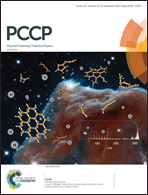An excited-state Wolff rearrangement reaction of 5-diazo Meldrum's acid: an ab initio on-the-fly nonadiabatic dynamics simulation†
Abstract
A global switching on-the-fly trajectory surface hopping dynamics simulation at the 3SA-CASSCF(12,11)/6-31G* quantum level has been employed to probe the photo-induced Wolff rearrangement (WR) reaction of 5-diazo Meldrum's acid (DMA) within three low-lying electronic excited states. The present simulation predicted that the branching ratios for relaxing back to the ground state, isomerizing to diazirine, and reaction to ketene I via carbene I are 69% ± 0.1, 3% ± 0.4, and 28% ± 0.1, which are in excellent agreement with those obtained by the femtosecond spectroscopy experiment, 67%, 3% and 30%, respectively. In particular, the present simulation revealed that the major WR reaction to ketene I pathway is stepwise via the excited-state to carbene I (17.8% ± 0.2) and via the ground-state to carbene I (8.7% ± 0.2), and the minor pathway is concerted synchronous (1.5% ± 0.6). The photo-induced WR reaction of DMA has been quantitatively interpreted in terms of the distribution of extended seam surfaces as a function of CN dissociation bonds for two important conical intersections within three low-lying electronic excited states. Ultrafast dynamic time constants have been estimated to be about 500 fs ± 120 fs and 180 fs ± 80 fs for the stepwise and the concerted WR reaction to ketene I which are also in good agreement with those determined by the experiment. Therefore, the photo-induced excited-state WR reaction mechanism has been quantitatively revealed by the present real-time dynamics simulation.



 Please wait while we load your content...
Please wait while we load your content...